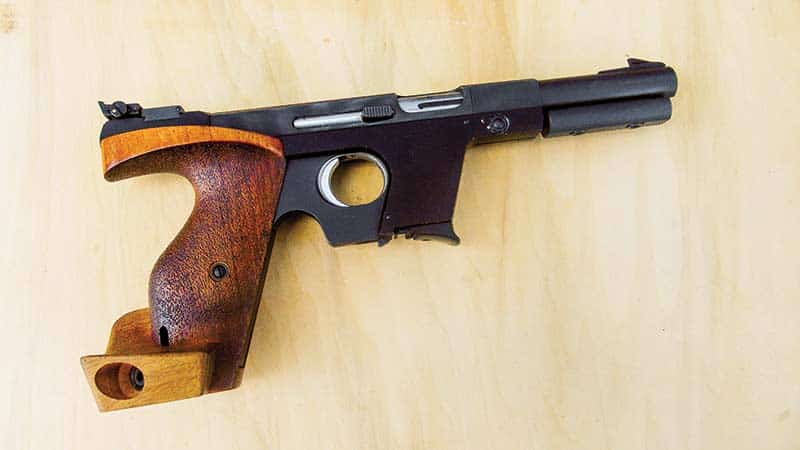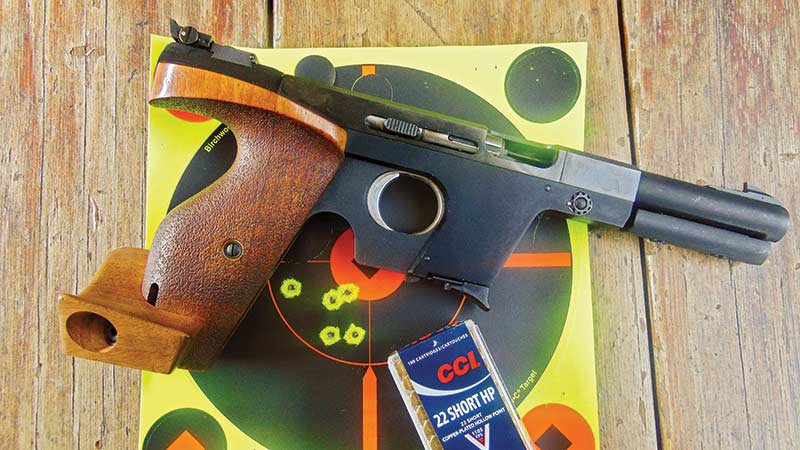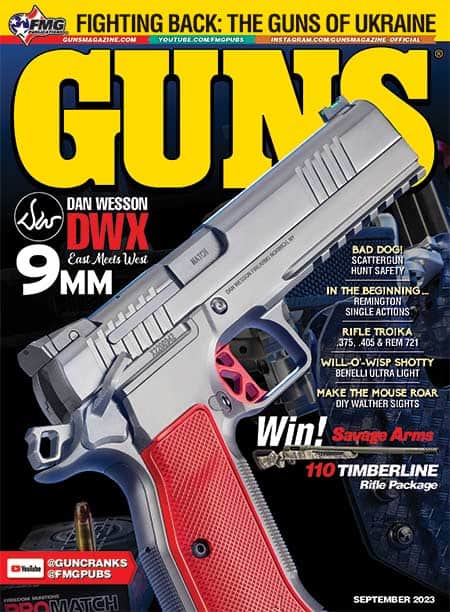Walther OSP
Still Getting The Best Out Of The .22 Short
In terms of specialization for a specific competitive purpose, few pistols — if any — can hold a candle to the Walther OSP.
The German term Schnellfeuer is printed on the box and the cover of the instruction pamphlet. It means “rapid fire,” which, as any historically knowledgeable shooter will recognize, is also the term used to describe the select-fire Mauser C96 “Broomhandle” of WWI fame.
Looks Don’t Deceive
But the Walther OSP is a semi-auto only rimfire — and one with Olympic credentials at that. Introduced more than 60 years ago, its Space Age appearance is striking even today. The OSP — along with Italy’s FAS OP 601 Domino — literally defines the term “purpose-built.” It simply looks accurate.
Designed solely for International 25-meter Rapid Fire, it was rendered obsolete when rule changes in 2004 no longer allowed a .22 Short chambering, wraparound grips and super-light trigger pulls. Cartridge-wise, it’s now .22 Long Rifle only.
All of these features, unfortunately, were hallmarks of the premium competition single-action auto OSP.
It suffered the same fate as Smith & Wesson’s more conventional appearing Model 41-1 (reviewed in the GUNS November 2022 issue). But, while the American pistol was never really a factor in going for the gold as only 1,000 were made, the thoroughly racy-looking Walther was a consistent medalist throughout and beyond its 1961-1994 production run. It was replaced by the Walther SSP in .22 LR. Fortunately, our resident rimfire fanatic, John Wightman, just happened to have a minty OSP to loan us.
Featuring a ported, weighted barrel, plus a very low bore axis, the OSP delivers just about the lowest recoil impulse achievable. This translates to a level of rapid-fire controllability required to compete in an exceptionally demanding event.
How demanding? Well, let’s again review the parameters of Rapid-Fire competition:
The course of fire is a doozy, consisting of five shots fired at a series of five 25-meter targets — one-handed of course — under successive time constraints of 8, 6 and 4 seconds. The scoring zone for a “10” incidentally is a scanty 10 cm in diameter — this is 3.9″ for the metrically challenged.
Felt recoil, as you might imagine, is virtually nonexistent, not surprising considering the OSP weighs 45 oz. and has an OAL of 11.8″. The trigger pull on our gun was 2.1 lbs. — about at rock bottom of the allowable pull weight.
The distinctive walnut, textured grips were designed by Switzerland’s Morini Competition Arm .S.A. Not to put too fine a point on it, but fitting your shooting hand to those grips is almost like slipping on a glove.
The sights are equal to the grips and trigger. The rear is fully adjustable and provides a great sight picture along with the front blade which, to be honest, is a bit on the skinny side for those of us used to conventional revolvers and autos!
Feeding Time
The Walther OSP is fed via a 5-round detachable magazine seated in front of the trigger guard. The magazine release is at the bottom rear of the mag well. It’s fairly minuscule and relatively tough to access, but since the OSP is obviously not designed for combat-type magazine changes, it’s okay. Speedy reloads are not a factor. Speedy shooting is.
As far as .22 Short ammo goes these days, the selection available is far below the .22 Long Rifle. We had some Winchester Super-X 29-grain Copper Plated LRNs marked “Low Noise” at a rated 1,095 fps, along with some livelier 27-grain CCI HPs at a rated 1,105 fps. Both brands clocked at around 100 to 120 fps less from the 5-3/4″ barrel of the OSP. We tried in vain to dig up any serious competition-grade ammo of the type likely to be used in international competition back when the .22 Short chambering was still kosher in Rapid Fire events.
We used what we had, and of our two brands, the CCI stuff gave us the best results at a long step or two past 25 yards from a sandbag rest. Our best effort? Five shots in 1.5″ with four of them in a 1″ cluster. This made us even more curious as to what could’ve been achieved with match-grade ammo — and with a match-grade shooter behind the gun, of course …
Nevertheless, the sandbag-rest results must’ve gone to our heads, so in a reckless burst of hubris we tried the pistol offhand and one-handed at the same distance. We managed to stay within the confines of the 8 ring on a 12″x18″ silhouette target for five shots. No attempts were made to fire the pistol “at speed.”
No, we certainly didn’t shoot up to the OSP’s potential but we did develop a huge amount of respect for the skill level of Rapid-Fire contestants. In our defense, we’ve been shooting two-handed — usually in a leisurely fashion — for as long as any of us can remember.
If you can find an OSP, expect to shell out anywhere from a cool grand to $1,700 for it. There’s nothing stopping you from trying replicate the Olympian feats of this super-cool artifact, or you can just employ it as a “high end” plinker or small game gun.






